Birds on the Mounts
BIRDS ARE GROUPED BY FAMILY
Residents and visitors have observed many species of birds at Mt Wilson and Mt Irvine. The goal of this section is to provide information on local birds, help make it easier to identify them, and to keep a record of birds which have been seen.
Birds will be added to this list when we are informed of the sighting.
AUSTRALIAN BRUSH TURKEY

Common Name:- Brush Turkey
Species:- Alectura lathami
Other Common Names:- frequently called the Scrub Turkey or Bush Turkey
The Australian Brush-turkey has a mainly black body plumage, bare red head, yellow throat wattle (pale blue in northern birds) and laterally flattened tail. The Australian Brush-turkey is not easily confused with any other Australian bird. It is the largest of Australia's three megapodes (Family Megapodiidae). The megapodes are a distinct family of the group of fowl-like birds (Order Galliformes), which includes quails, turkeys, peafowl and junglefowl.
QUAILS

Common Name:- Brown Quail
Species:- Coturnix ypsilophora
Other Common Names:- Swamp Quail
The Brown Quail is a small, plump ground-dwelling bird. It is variable in colour, ranging from red brown to grey brown with fine white streaks and black barring above, and chestnut brown below. The eye is red to yellow, the bill black and the legs and feet orange-yellow. Female Brown Quails are larger and may be more heavily marked with black and paler below than males. Young birds are like adult females, with less distinct markings and a dark brown eye. Quails rarely fly, preferring to hide unless an intruder flushes them; then they fly low to the ground, with a rapid whirring flight.
DUCKS AND SWANS
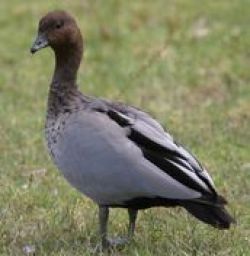
Common Name:- Australian Wood Duck
Species:- Chenonetta jubata
Other Common Names:- Maned Duck or Maned Goose
The Australian Wood Duck is a medium-sized 'goose-like' duck with a dark brown head and a pale grey body with two black stripes along the back. Males have the darker head and a small dark mane, with a speckled brown-grey breast and a black lower belly and undertail. The females have a paler head with two white stripes, above and below the eye, a speckled breast and flanks, with a white lower belly and undertail. In flight, the wings are pale grey above, contrasting with black wingtips, and have a noticeable white bar on the underside (the secondaries). They walk easily on land and may be seen perching on logs and in trees. They will only take to open water when disturbed. This species is also known as the Maned Duck or the Maned Goose.
AUSTRALASIAN GREBE

Common Name:- Australasian Grebe
Species:- Tachybaptus novaehollandiae
Other Common Names:-
The Australasian Grebe is a small waterbird with two distinct plumage phases. The non-breeding plumage of both the male and female is dark grey-brown above and mostly silver-grey below, with a white oval patch of bare skin at the base of the bill. During the breeding season, both sexes have a glossy-black head and a rich chestnut facial stripe which extends from just behind the eye through to the base of the neck. At this time, the eye becomes darker and the patch of skin at the base of the bill becomes pale yellow and more noticeable. When approached, Australasian Grebes usually dive under water.
AUSTRALASIAN DARTER
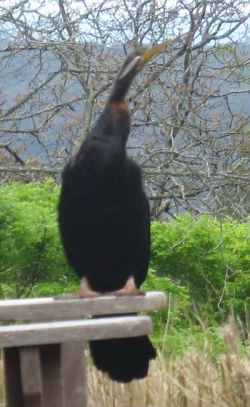
Common Name:- Darter
Species:- Anhinga-novaehollandiae
Other Common Names:- Snakebirds
The Darter is a large, slim water bird with a long snake-like neck, sharp pointed bill, and long, rounded tail. Male birds are dark brownish black with glossy black upperwings, streaked and spotted white, silver-grey and brown. The strongly kinked neck has a white or pale brown stripe from the bill to where the neck kinks and the breast is chestnut brown. Females and immatures are grey-brown above, pale grey to white below, with a white neck stripe that is less distinct in young birds. The Darter is often seen swimming with only the snake-like neck visible above the water, or drying its wings while perched on a tree or stump over water.
They take fish from local ponds. The Darter catches fish with its sharp bill partly open while diving in water deeper than 60 cm. The fish is pierced from underneath, flicked onto the water's surface and then swallowed head first. Smaller items are eaten underwater and large items may be carried to a convenient perch and then swallowed. Insects and other aquatic animals, including tortoises, may also be eaten, as well as some vegetable matter.
HERONS AND EGRETS

Common Name:- White-necked Heron
Species:- Ardea pacifica
Other Common Names:- Pacific Heron
The White-necked Heron is a large heron with a white head and a long white neck with a double line of black spots running down the front. The upperparts of the body are slate-black, with plum-coloured nuptial plumes on the back and breast during the breeding season. Underparts are grey streaked with white. The bill is black, the naked facial skin is is blue or yellow, the eyes are green, and the legs and feet are black.
The Heron eats fish, frogs, insects and reptiles in local ponds. White-necked Herons feed by wading in shallow water or stalking through wet grass looking for fish, amphibians, crustaceans and insects. Farm dams and irrigation and drainage ditches provide feeding habitat for White-necked Herons.
IBISES AND SPOONBILLS
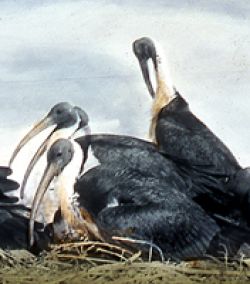
Common Name:- Straw-necked Ibis
Species:- Threskiornis spinicollis
Other Common Names:-
The Straw-necked Ibis is a large waterbird with a naked black head, long downcurved black bill and yellow throat plumes. It has a glossy blue-black back, with metallic purple, green and bronze sheen, a white nape and sides of neck and white underparts. Its preference for grassland insects such as grasshoppers and locusts have earnt it the name of Farmer's Friend.
MASKED LAPWING
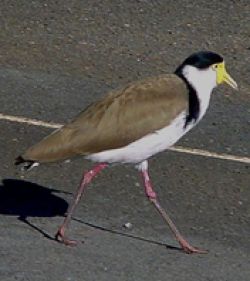
Common Name:- Masked Lapwing
Species:- Vanellus miles
Other Common Names:- Masked Plover, Spur-winged Plover or just Plover
Masked Lapwings are large, ground-dwelling birds that are closely related to the waders. The Masked Lapwing is mainly white below, with brown wings and back and a black crown. Birds have large yellow wattles covering the face, and are equipped with a thorny spur that projects from the wrist on each wing. The spur is yellow with a black tip. The Masked Lapwing has two subspecies resident in Australia. The southern subspecies has black on the hind neck and sides of breast, and has smaller facial wattles.
EAGLES, KITES AND GOSHAWKS

Common Name:- Brown Goshawk
Species:- Accipiter fasciatus
Other Common Names:-
Brown Goshawks are medium-sized raptors (birds of prey). They have a brown head, slate-grey to brown upperparts with a red-brown collar across the upper nape of the neck, and finely barred underparts of red-brown with white. The rounded wings are dark brown to grey above and buff to reddish brown below with darker wingtips, and the long rounded tail is grey with dark bars. The long legs are yellow, with reddish brown feathering about the thighs. The eye is bright yellow. Males are smaller than females. Young birds have grey-brown eyes, with brown, streaky plumage. There are several subspecies, with the northern sub-species, didimus, being generally smaller and paler. The Brown Goshawk is widespread but secretive.
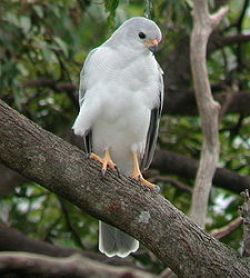
Common Name:- Grey Goshawk
Species:- Accipiter novaehollandiae
Other Common Names:-
The Grey Goshawk is a medium-sized raptor (bird of prey), with two colour morphs (forms). The grey morph has a grey head and upperparts, with white underparts barred grey on the chest. The rounded wings are grey above, white below, and have darker wingtips. The medium length tail is grey above and white below, barred grey. The white morph is pure white all over and is often known as the White Goshawk. Both morphs have a dark red eye and yellow legs and feet. However, this species is so variable in colour and size that it can be known as the Variable Goshawk.
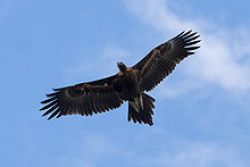
Common Name:- Wedge-tailed Eagle
Species:- Aquila audax
Other Common Names:- Eaglehawk
The Wedge-tailed Eagle has long wings (wingspan 2.3 m), a characteristic long, wedge-shaped tail, and legs that are feathered all the way to the base of the toes. The bill is pale pink to cream, the eye brown to dark brown, and the feet off-white. Young Wedge-tailed Eagles are mid brown in colour with reddish-brown heads and wings. They become progressively blacker for at least the first ten years of their lives; adults are mostly dark blackish-brown. The only difference in plumage between the sexes is that a female adult is generally slightly paler than her mate. Females (4.2 kg - 5.3 kg) are also larger and heavier than males (3.2 kg up to 4.0 kg). Wedge-tailed Eagles are Australia's largest raptors (birds of prey).
PIGEONS AND DOVES

Common Name:- White-headed Pigeon
Species:- Columba leucomela
Other Common Names:-
The White-headed Pigeon is a large pigeon with a distinctive white head, neck and breast, which sometimes have an orange or greyish wash. The back, wings and tail are dark grey to black and the underparts are grey. The male has a metallic green or purple sheen, and the female often has a darker cap and is usually greyer. Young White-headed Pigeons resemble darker females. The eye ring is pink to dark red and the legs and feet are also pink-red.
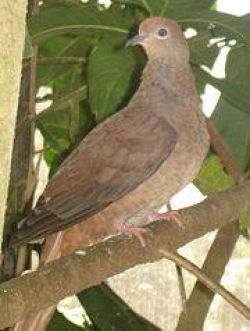
Common Name:- Brown Cuckoo-Dove
Species:- Macropygia amboinensis
Other Common Names:- Brown Pigeon, Pheasant Pigeon
The Brown Cuckoo-Dove is a large brown pigeon of rainforests, with a very long, tapering tail. There is a pale streak below the blue-grey eye and a red eye-ring. The female has a brighter chestnut cap and a scaly pattern on the breast. The legs and feet are red. Their flight is strong and graceful, usually low among the trees. This species is also known as the Brown Pheasant or Large-tailed Pigeon.

Common Name:- Common Bronzewing
Species:- Phaps chalcoptera
Other Common Names:-
Common Bronzewings are medium-sized, heavily built pigeons.
The male has a yellow-white forehead and pink breast. Both sexes have a clear white line below and around the eye and patches of green, blue and red in the wing, characteristic of all bronzewings. The Common Bronzewing is a cautious pigeon, and rarely allows close approach. If startled, it flies away with a clatter, keeping low to the ground while moving in a steady, direct manner. Young Common Bronzewings are duller and browner than the adults. The metallic wing patch is absent or not easily seen.

Common Name:- Brush Bronzewing
Species:- Phaps elegans
Other Common Names:-
The Brush Bronzewing is a dark olive-brown above with rich chestnut nape and shoulders, with blue-grey underparts. There are two curved bronze irridescent blue-green bars across each wing. A dark, chestnut stripe through eyes, underlined by white and a chestnut throat patch are distinguishing features. The male has a chestnut forehead. The female lacks the forehead patch and is generally duller.
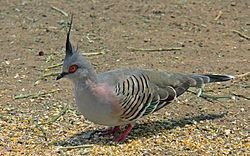
Common Name:- Crested Pigeon
Species:- Ocyphaps lophotes
Other Common Names:-
The Crested Pigeon is a stocky pigeon with a conspicuous thin black crest. Most of the plumage is grey-brown, becoming more pink on the underparts. The wings are barred with black, and are decorated with glossy green and purple patches. The head is grey, with an pinkish-red ring around the eye. If startled, this pigeon takes to the air with a characteristic whistling flight, and glides with down turned wings. The whistling sound is produced by the air passing over a modified primary feather on the wing. Upon landing, the pigeon swings its tail high in the air.
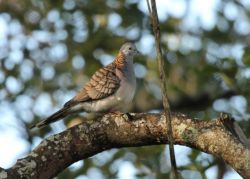
Common Name:- Bar-shouldered Dove
Species:- Geopelia humeralis
Other Common Names:- Mangrove Dove, Scrub Dove, or Kookawook
The Bar-shouldered Dove is a medium-sized, long-tailed dove. Adults doves have a blue-grey head, neck and upper breast, with a distinctive reddish-bronze patch on the hindneck, with dark barring. Young doves lack this patch and barring and tend to be duller overall. There is also a distinctive pinkish bar on the lower breast. The lower body is pale. They have a blue-grey eye-ring and reddish eye. They are usually seen in pairs or small parties. The northern subspecieshedlandi is lighter in colour. This species is also known as the Mangrove Dove, Scrub Dove, or Kookawook.
Bar-shouldered Doves are found in humid and well-wooded regions of north-western, northern and eastern Australia from near Onslow in Western Australia to Bega in New South Wales, as well as in southern New Guinea. The subspecies hedlandi is restricted to the Pilbara region.
Bar-shouldered Doves feed on the ground in short grass near cover. They need to drink throughout the day. They mainly eat seeds of grasses, herbs and sedges, as well as rhizomes (small root storages).
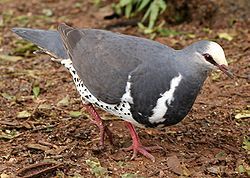
Common Name:- Wonga Pigeon
Species:- Leucosarcia-picata
Other Common Names:-
The Wonga Pigeon, or Wonga Wonga, is a large, plump, ground-dwelling pigeon with a small head, short, broad wings and a long tail. It is mainly grey above, with a pale face, a distinctive white V on the breast and white lower parts which are boldly marked with black-brown crescents and wedges. The eyes are dark red-brown with a pink eye-ring and black lores (area between the bill and the eye) and the bill, feet and legs are deep pink to red. Young Wonga Pigeons are browner above and the V is less distinct. A shy bird, except in areas where it has become used to humans, it will take off with explosive wing-claps if disturbed.
COCKATOOS
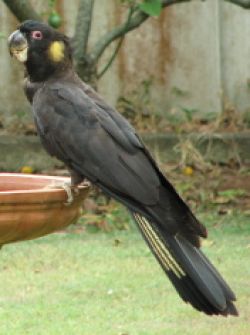
Common Name:- Yellow-Tailed Black Cockatoo
Species:- Calyptorhynchus funereus
Other Common Names:-
The Yellow-tailed Black-Cockatoo is a large cockatoo. It is easily identified by its mostly black plumage, with most body feathers edged with yellow, not visible at a distance. It has a yellow cheek patch and yellow panels on the tail. The female has a larger yellow cheek patch, pale grey eye-ring (pink in males), white upper bill (grey-black in males) and black marks in the yellow tail panels. Young birds resemble the adult female, but young males have a smaller cheek patch.

Common Name:- Gang Gang Cockatoo
Species:- Callocephalon fimbriatum
Other Common Names:-
The Gang-gang Cockatoo, or Gang Gang for short, is a small, stocky cockatoo with a wispy crest, large, broad wings and a short tail. The adult male has a distinctive scarlet red head and crest, with the rest of the body slate-grey. The adult female has a dark grey head and crest, with the feathers of the underparts edged pink and yellow. In both sexes, the feathers of the upperparts and wings are faintly edged pale-grey, giving a barred appearance, with females having additional yellow edging to their feathers that increases this barred effect. Young birds are similar to the adult female, with young males differing by having a red crown and forehead and a shorter, less twisted red crest. Gang-gangs are gregarious but relatively quiet cockatoos, and may usually be located in food trees by the sounds of feeding and falling debris.
PARROTS AND LORIKEETS
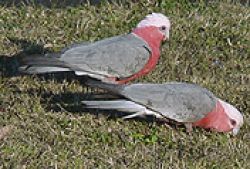
Common Name:- Galah
Species:- Eolophus roseicapilla
Other Common Names:- Rose-breasted Cockatoo, Galah Cockatoo, Roseate Cockatoo or Pink and Grey
The Galah can be easily identified by its rose-pink head, neck and underparts, with paler pink crown, and grey back, wings and undertail. Birds from the west of Australia have comparatively paler plumage. Galahs have a bouncing acrobatic flight, but spend much of the day sheltering from heat in the foliage of trees and shrubs. Huge noisy flocks of birds congregate and roost together at night.
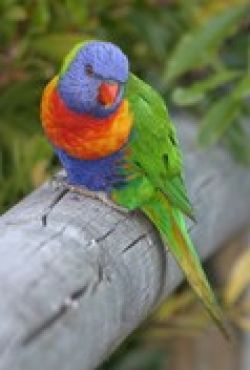
Common Name:- Rainbow Lorikeet
Species:- Trichoglossus haematodus
Other Common Names:-
The Rainbow Lorikeet is unmistakable with its bright red beak and colourful plumage. Both sexes look alike, with a blue (mauve) head and belly, green wings, tail and back, and an orange/yellow breast. They are often seen in loud and fast-moving flocks, or in communal roosts at dusk. Rainbow Lorikeets are such colourful parrots that it is hard to mistake them for other species. The Rainbow Lorikeet is found in a wide range of treed habitats including rainforest and woodlands, as well as in well-treed urban areas.

Common Name:- Australian King Parrot
Species:- Alisterus scapularis
Other Common Names:- Diamondbird
Male Australian King-Parrots are the only Australian parrots with a completely red head. Females are similar to males except that they have a completely green head and breast. Both sexes have a red belly and a green back, with green wings and a long green tail. King parrots are normally encountered in pairs or family groups.

Common Name:- Crimson Rosella
Species:- Platycercus elegans
Other Common Names:- Red Lowry, Pennant's Parakeet, Campbell Parakeet, (Blue) Mountain Parrot, (Blue) Mountain Lowry or just plain Lowry
There are several colour forms of the Crimson Rosella. The form it is named for has mostly crimson (red) plumage and bright blue cheeks. The feathers of the back and wing coverts are black broadly edged with red. The flight feathers of the wings have broad blue edges and the tail is blue above and pale blue below and on the outer feathers. Young Crimson Rosellas have the characteristic blue cheeks, but the remainder of the body plumage is green-olive to yellowish olive (occasionally red in some areas). The young bird gradually attains the adult plumage over a period of 15 months

Common Name:- Eastern Rosella
Species:- Platycercus eximius
Other Common Names:-
Eastern Rosellas are medium-sized colourful parrots with distinctive white cheek patches. It has a red head, neck and breast, with yellowish to greenish upper parts, a yellow underbody and a yellow-green to blue-green rump, with a red undertail. The shoulders are bright blue. Females are usually similar to males, but sometimes duller and young birds are even duller and can be aged by their bill colour, which is yellow or orange, changing to off-white when mature.
CUCKOOS

Common Name:- Fan-Tailed Cuckoo
Species:- Cacomantis flabelliformis
Other Common Names:-
The Fan-tailed Cuckoo is a slender cuckoo and the adult bird is easily identified by a yellow eye ring (slightly greenish in young birds), its generally dark slate-grey back and wings, becoming pale rufous below, with a boldly barred black and white under tail. Younger birds are duller and browner in colour.
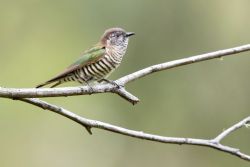
Common Name:- Shining Bronze-Cuckoo
Species:- Chalcites lucidus
Other Common Names:-
The Shining Bronze-Cuckoo is a small cuckoo with irridescent green upper parts, white underparts with bold dark, mostly unbroken barring , and a very white face with fine, dark mottling. It has no distinct white eye-brow nor dark eye-stripe and no reddish colour in wings and little or no reddish colour in its tail.

Common Name:- Horsfields Bronze-Cuckoo
Species:- Chrysococcyx basalis
Other Common Names:-
Horsfield's Bronze-Cuckoo is an olive-brown above with pale scaling and a bronze to green sheen on the back and upper tail. It has a prominent dark-brown eyestripe, with a contrasting white eyebrow stripe above, with both curving down the sides of the neck. The throat is white with fine dark mottling.The underbody is white to cream with dark-brown barring at the sides, with the bars joining in the middle on the upper breast only. The undertail is grey with brown and white barring at the tip and sides. The tail is edged rufous (orange-brown) and the undertail is rufous when spread. Juveniles are similar but duller with faint or no barring on sides of body.
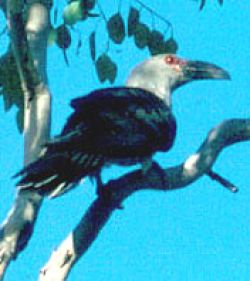
Common Name:- Channel-billed Cuckoo
Species:- Scythrops novaehollandiae
Other Common Names:-
Apart from the Channel-billed Cuckoo's large size, its massive pale, down-curved bill, grey plumage (darker on the back and wings) and long barred tail make it difficult to confuse it with any other bird. In flight the long tail and long wings give the bird a crucifix-shaped (cross-shaped) silhouette. Young Channel-billed Cuckoos have more mottled buff, brown and grey plumage. Although they are not nocturnal birds (night birds) in the strict sense, Channel-billed Cuckoos are notorious for calling all night long during the breeding season. This species is sometimes known as the Storm-bird or Stormbird.
OWLS

Common Name:- Powerful Owl
Species:- Ninox strenua
Other Common Names:-
The Powerful Owl is a large owl with a relatively small head and a rounded tail. It is dark grey to dark grey-brown above, with white barring, and off-white below, with distinctive dark v-shaped chevrons. The eyes are yellow, set in a dark grey/brown facial mask. The legs are feathered and the yellow to orange feet are massive, with sharp talons. The sexes are alike but the female is slightly smaller, with a narrower head. Juvenile birds are downy white on the head and underparts, the underparts are sparsely streaked, and they have shorter tails than the adults. Powerful Owls are the largest of the Australian nocturnal birds (night birds).

Common Name:- Southern Boobook Owl
Species:- Ninox novaeseelandiae
Other Common Names:- also called the Southern Boobook, Mopoke, Morepork or Ruru
The Southern Boobook is the smallest and most common owl in Australia. It is identified by its plumage, which is dark chocolate-brown above and rufous-brown below, heavily streaked and spotted with white. The bill is grey with a darker tip, and the feet are grey or yellow. The facial disc is chocolate brown and the eyes are large and yellowish. Young Southern Boobooks are almost entirely buff-white below, with conspicuous dark brown facial discs. Like other owl species, the Southern Boobook is nocturnal. Birds are often observed perched on an open branch or tree-top. It is also known as the 'Mopoke'.

Common Name:- Sooty Owl
Species:- Tyto tenebricosa
Other Common Names:- Greater Sooty Owl
The Sooty Owl, also known as the Greater Sooty Owl, is a medium to large owl. They have a finely white spotted head with scattered white spots on the wings. The females are lighter colored than the males. The females length is 37–43 cm and weighs 750-1000 gm. The male is smaller and length is 37–43 cm and weighs 500-700 gm. The wing length is 30–40 cm. The large dark eyes are set in a round large facial disk. The facial disk is dark gray silver or sooty black and has a heavy black edge. The upper part of the owl is black to dark gray and the under part is lighter. Their call is a piercing shriek which can last up to two seconds. The tail is short and the legs are feathered large black talons. They are nocturnal and hide in hollow tree trunks, caves and in tall trees with heavy foliage.

Common Name:- Barn Owl
Species:- Tyto alba
Other Common Names:- Common Barn Owl
Barn Owls are moderately common, but generally hard to see, as they are mostly active at night. During the day, the birds roost on concealed tree branches. They are the most widespread and familiar of the owls. Barn Owls are medium sized birds (females slightly larger than males), with a 'heart-shaped' facial disc. They have sandy orange and light grey upperparts and white to cream underparts. Both the back and breast are evenly spotted with black. Birds often appear whiter than normal when illuminated in car headlights or torches. Young birds are similar to adults in plumage. When threatened, the Barn Owl crouches down and spreads its wings.
FROGMOUTHS AND NIGHTJARS
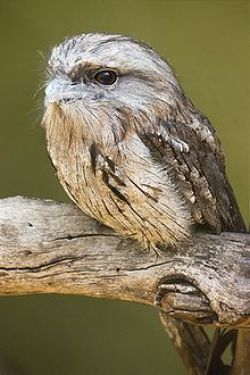
Common Name:- Tawny Frogmouth
Species:- Podargus strigoides
Other Common Names:- incorrectly use the colloquial names of "Mopoke" or "Morepork"
The general plumage of the Tawny Frogmouth is silver-grey, slightly paler below, streaked and mottled with black and rufous. A second plumage phase also occurs, with birds being russet-red. The eye is yellow in both forms, and the wide, heavy bill is olive-grey to blackish. South-eastern birds are larger than birds from the north. Tawny Frogmouths are nocturnal birds (night birds). During the day, they perch on tree branches, often low down, camouflaged as part of the tree.
KINGFISHERS
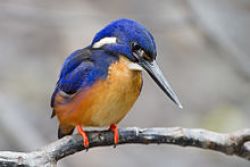
Common Name:- Azure Kingfisher
Species:- Ceyx-azureus
Other Common Names:-
The Azure Kingfisher is a small kingfisher with a long slender black bill and a short tail. The head, neck, upper parts and breast sides are deep azure blue with a violet (purplish) sheen. The neck has a distinctive orange stripe on each side and there is a small orange spot before each eye. The throat is pale orange-white, grading to orange-reddish on belly and undertail. The flanks and sides of the breast are washed purple to violet. The legs and feet are red. The sexes are similar. Young birds
have a darker cap and are generally duller.
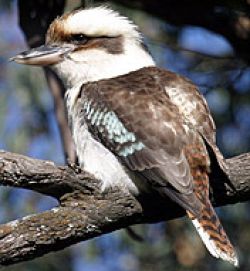
Common Name:- Laughing Kookaburra
Species:- Dacelo novaeguineae
Other Common Names:- Laughing Jackass and Giant Kingfisher
The Laughing Kookaburra is instantly recognisable in both plumage and voice. It is generally off-white below, faintly barred with dark brown, and brown on the back and wings. The tail is more rufous, broadly barred with black. There is a conspicuous dark brown eye-stripe through the face. It is one of the larger members of the kingfisher family.
SUPERB LYREBIRD

Common Name:- Superb Lyrebird
Species:- Menura novaehollandiae
Other Common Names:-
The Superb Lyrebird looks like a large brown pheasant. The wings are rufous in colour and the bill, legs and feet are black. The adult male has an ornate tail, with special curved feathers that, in display, assume the shape of a lyre. The tails of females and young males are long, but lack the specialised feather. Females are smaller than males.
TREECREEPERS

Common Name:- White-throated Treecreeper
Species:- Cormobates leucophaea or Cormobates-leucophaeus
Other Common Names:-
The White-throated Treecreeper is dark brown, with a distinctive white throat and chest, and white streaks on its flanks, edged with black. The wings have a red bar that is visible in flight and the undertail is barred. The female has an orange mark on the sides of the face. Like other treecreepers, spends most of its time foraging in trees and has a short, spiralling flight.
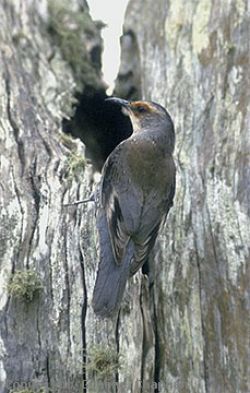
Common Name:- Red-browed Treecreeper
Species:- Climacteris erythrops
Other Common Names:-
The Red-browed Treecreeper (Climacteris erythrops) is a species of bird in the Climacteridae family. It is endemic to Australia. Its natural habitats are subtropical or tropical moist lowland forests and subtropical or tropical moist montane forests.
FAIRY-WRENS
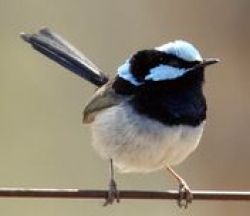
Common Name:- Superb Fairywren
Species:- Malurus cyaneus
Other Common Names:- Superb Blue-wren or colloquially as the Blue Wren
Adult male Superb Fairy-wrens are among the most brightly coloured of the species, especially during the breeding season. They have rich blue and black plumage above and on the throat. The belly is grey-white and the bill is black. Females and young birds are mostly brown above with a dull red-orange area around the eye and a brown bill. Females have a pale greenish gloss, absent in young birds, on the otherwise brown tail. The legs are brown in both sexes. Males from further inland and in the south-west of the range have more blue on the back and underparts.
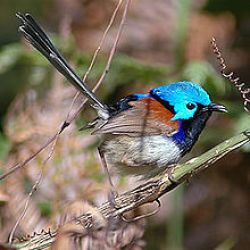
Common Name:- Variegated Fairywren
Species:- Malurus lamberti
Other Common Names:-
The breeding male Variegated Fairy-wren is brightly coloured. The crown and sides of the head are blue, and the shoulder patch is a rich chestnut. The depth and variety of colours in the male varies among the four subspecies, distributed across the Australian mainland. Non-breeding males, females and young birds are brownish grey.
PARDALOTES

Common Name:- Spotted Pardalote
Species:- Pardalotus punctatus
Other Common Names:- Diamondbird
The Spotted Pardalote is a tiny bird that is most often high in a eucalypt canopy, so it is more often detected by its characteristic call. The wings, tail and head of the male are black and covered with small, distinct white spots. Males have a pale eyebrow, a yellow throat and a red rump. Females are similar but have less-distinct markings.
SCRUBWRENS, THORNBILLS AND GERYGONES

Common Name:- Pilotbird
Species:- Pycnoptilus floccosus
Other Common Names:-
The Pilotbird is a large, plump species of acanthizid, measuring around 18 cm in length and weighing 27 g. It has a large head and a short bill. The plumage is mostly brown with scalloping on the chest and an orangeish throat. The species is highly terrestrial. The name of the species comes from its supposed habit of following lyrebirds, taking prey that they flush. This habit is well known but seldom observed.

Common Name:- Rockwarbler
Species:- Origma solitaria
Other Common Names:-
The Rockwarbler is a small bird restricted to the sandstone formations around the Sydney region of New South Wales. It is a dark brown-grey bird with a cinnamon-tinged face and forehead, a dull white throat speckled black, reddish-brown underparts, and a black tail, which is often flicked sideways. The wings are dark grey-brown. Young birds are similar to adults but duller.
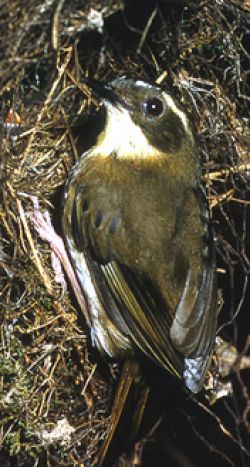
Common Name:- Yellow-throated Scrubwren
Species:- Sericornis citreogularis
Other Common Names:-
The Yellow-throated Scrubwren is a small, ground-dwelling bird with a distinctive black face mask and forehead, which is bordered by a white and yellow eyebrow above and a bright yellow throat below. The crown and back are dark olive-brown, the underparts grade from the yellow throat to white on the belly, with the flanks washed olive. The wings are dark grey brown with the outer edges yellowish. The relatively long legs are cream to pinkish-grey and the bill is black. Females tend to have a brown face mask and forehead. Young birds are duller than adults in colour, with the underparts washed fawn.
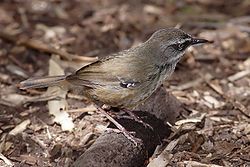
Common Name:- White-browed Scrubwren
Species:- Sericornis frontalis
Other Common Names:-
White-browed Scrubwrens are mostly dark olive-brown above, while the throat is buff grey and the flanks, belly and rump are dull rufous. They have a white line above the eye and another below the eye. The area around the eye between the lines is black, becoming greyer near the ear. The eye is light cream. Males and females are similar, but the females are slightly duller, particularly on the face. Young White-browed Scrubwrens are similar to the adults, but are generally duller, with more chocolate-brown backs and duskier faces.
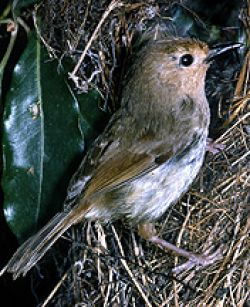
Common Name:- Large-billed Scrubwren
Species:- Sericornis magnirostra
Other Common Names:-
The Large-billed Scrubwren is a medium-sized, plain-coloured, arboreal (tree-dwelling) scrubwren with a rather short tail. Its long, dagger-like bill appears tilted upwards. The large dark red-brown eye stands out in the pale buff (orange-brown) face. The upperparts are olive-brown, more red-brown on the head and rump and the base of tail is washed rufous (reddish), with light buff underparts.
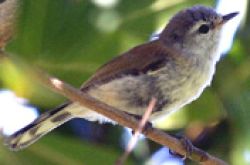
Common Name:- Brown Gerygone
Species:- Gerygone mouki
Other Common Names:- Brown Warbler
The Brown Gerygone is a small bird, olive-grey (race richmondi, in south) to buff-brown (race mouki, in north) above, with a pale grey face and underparts, with the flanks washed brown. It has a long white eyebrow and a red-brown eye. The tail band is dark and the tail tips are white. It is usually seen in pairs or small parties, fluttering around foliage. Also known as the Brown Warbler.

Common Name:- Brown Thornbill
Species:- Acanthiza pusilla
Other Common Names:-
The Brown Thornbill is a small bird, but is one of the medium-sized and more common of the thornbills. It has olive-brown to grey upperparts, with a warm reddish-brown forehead scalloped with paler markings. The rump has a reddish-brown patch, the tail is grey-brown with a black band and a pale tip, and the underparts are off-white, streaked blackish on the chin, throat and chest. The eye is dark red. The sexes are similar and young birds are only slightly different to adults, with a duller eye.
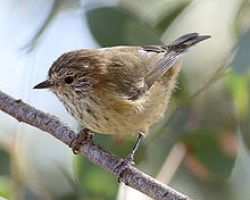
Common Name:- Striated Thornbill
Species:- Acanthiza lineata
Other Common Names:-
The Striated Thornbill is a medium-sized thornbill with greenish upperparts, an orange-brown cap, streaked distinctively with white and off-white to cream underparts, heavily streaked on chin, throat and breast. The sexes are similar and young birds are only slightly different to adults, with less streaking on the underside.
HONEYEATERS
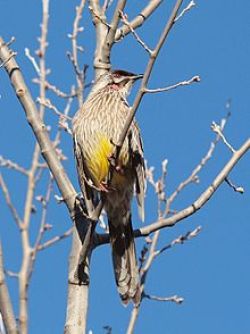
Common Name:- Red Wattlebird
Species:- Anthochaera carunculata
Other Common Names:- also known as Barkingbird or Gillbird
The Red Wattlebird is a large, noisy honeyeater. The common name refers to the fleshy reddish wattle on the side of the neck. The plumage is grey-brown on the body, with prominent white streaks and yellow on the belly. The face is pale and the tail is long with a white-tip. Young Red Wattlebirds are duller than the adult and have a brown, rather than reddish, eye. The wattle is also very small and pale.
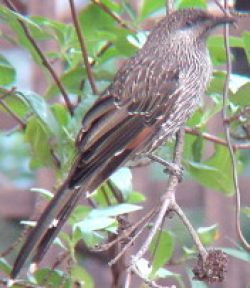
Common Name:- Little Wattlebird
Species:- Anthochaera chrysoptera
Other Common Names:- Brush Wattlebird
The Little Wattlebird is a medium to large honeyeater, but is the smallest of the wattlebirds. It is mostly dark grey-brown above, with faint white shafts on each of the feathers. The underparts are grey and are heavily streaked with white. The streaks are finer around the throat, becoming more blotched on the sides of the belly. In flight, there is a large rufous patch in the wings. The eye is blue-grey. The sexes are similar. Young Little Wattlebirds resemble the adults, but are duller, have less streaking and a have a browner eye.
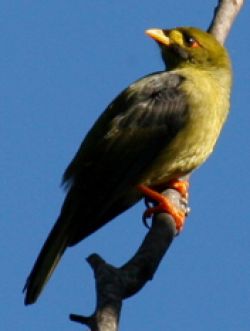
Common Name:- Bell Miner
Species:- Manorina melanophrys
Other Common Names:- Bellbird
Much more likely to be heard or seen at Mt Irvine than Mt Wilson. The Bell Miner is the smallest of the miners and is a medium-large and solidly built honeyeater. It is mostly olive-green, with a short, down-curved, bright yellow bill, a red-orange bare eye patch and orange-yellow feet and legs. It has a squared off tail. Males are slightly larger, but otherwise the sexes are similar. Young birds are duller and browner, with a paler eye patch. More often heard than seen, the Bell Miner lives in large colonies and aggressively defend their territories against all intruders. Also commonly known as Bellbirds.

Common Name:- Lewin's Honeyeater
Species:- Meliphaga lewinii
Other Common Names:-
The Lewin's Honeyeater is small to medium in size. It is dark greenish grey in colour, with a creamy yellow gape (fleshy corners of the mouth). It has large, yellowish crescent-shaped ear patches. In flight, the pale yellow edges of the flight feathers can be seen. The bill is black and the eye is blue-grey. Both sexes are similar in appearance. Young Lewin's Honeyeaters are similar to the adults, but have brown eyes.
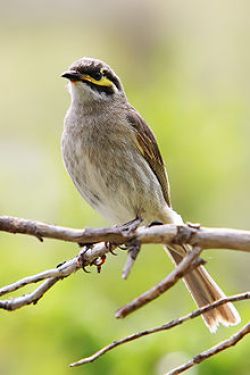
Common Name:- Yellow Faced Honeyeater
Species:- Lichenostomus chrysops
Other Common Names:-
The Yellow-faced Honeyeater migrates north from Mt Wilson & Mt Irvine about May but returns in the spring and summer. It is a medium to small, plainly coloured honeyeater with a slightly down-curved bill. It is dark grey-brown above, with some brown streaking on the head, and paler below with lighter streaks. It has a distinctive, broad yellow face-stripe, bordered with black. The males are slightly larger but the sexes are otherwise similar. Young are paler and unstreaked on the head. It can be seen in large flocks when migrating, and in smaller groups when feeding.

Common Name:- White Eared Honeyeater
Species:- Lichenostomus leucotis
Other Common Names:-
The White-eared Honeyeater is a medium-sized honeyeater with a strong bill. It is olive-green above with lighter green underparts. It has a grey cap, a black face and bib (under bill) with a distinctive, contrasting white ear-patch. The sexes are similar in plumage but the males are larger. Young are duller and browner. Usually seen in pairs or small family groups, and are quite noisy and conspicuous.

Common Name:- White Naped Honeyeater
Species:- Melithreptus lunatus
Other Common Names:-
The White-naped Honeyeater is a small honeyeater with a short, slender bill. It is olive-green above, with a black cap, a white band across the back of the neck which does not reach the eye, and a bright orange crescent above the eye. The flanks and sides of the breast are washed grey brown and the underparts are white. Young birds lack the black cap and the white nape is duller or absent. It can be seen in large flocks when migrating, often with other honeyeaters, and in smaller groups when feeding.
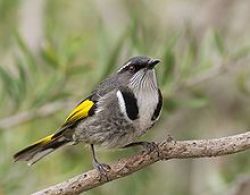
Common Name:- Crescent Honeyeater
Species:- Phylidonyris pyrrhopterus or Phylidonyris pyrrhoptera
Other Common Names:-
The Crescent Honeyeater is a medium to small honeyeater with a long down-curved bill and a red-brown eye. Males are dark grey above with yellow wing patches, a white streak above the eye and a distinctive dark crescent across each side of the breast, outlined below with a white line. The rest of the underparts are a pale brown grey to white, with prominent white markings on the tail. Females are smaller and are olive brown above, with an olive brown crescent on each side of the breast, white to brown grey underparts, and olive yellow wing patches. Young birds resemble adults, but lack strong breast markings.
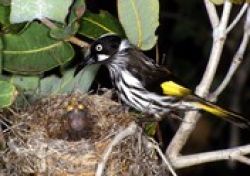
Common Name:- New Holland Honeyeater
Species:- Phylidonyris novaehollandiae
Other Common Names:-
The New Holland Honeyeater is mostly black and white, with a large yellow wing patch and yellow sides on the tail. It has a small white ear patch, a thin white whisker at the base of the bill and a white eye. This honeyeater is an active bird, and rarely sits still long enough to give an extended view. Sexes are similar in looks, but females are slightly smaller in size. Young birds are browner and have a grey eye.
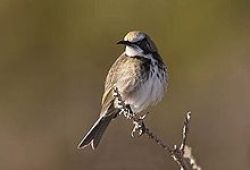
Common Name:- Tawny-Crowned Honeyeater
Species:- Gliciphila melanops
Other Common Names:-
The Tawny-crowned Honeyeater is pale brown above fading to white below, with a whitish throat and bib. Its tawny crown is separated from a black face by a white line from beak, over the eye and curving down behind the ear. The black facial feathers curve down to a black "wishbone" either side of bib. It has a slender curved black bill. The juvenile's crown is browner with white streaks, with no white line, the face is brown and "wishbone" pattern is less pronounced and streaky. Its throat is yellow.
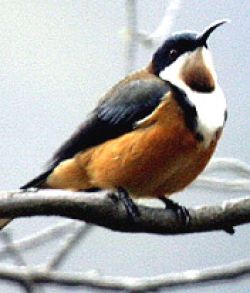
Common Name:- Eastern Spinebill
Species:- Acanthorhynchus tenuirostris
Other Common Names:- Honeyeater
13–16 cm (5–6 in) long, the male Eastern Spinebill has a long thin downcurved black bill with a black head, white throat with a reddish patch and red iris. It has a brownish-red nape, a grey brown back and pale cinnamon underparts. The dark tail is tipped with white laterally. Females and juveniles are smaller and duller. The call is a rapid piping.
JACKY WINTER
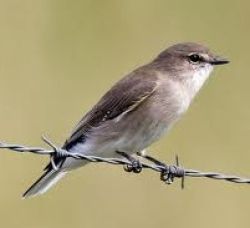
Common Name:- Jacky Winter
Species:- Microeca fascinans
Other Common Names:- Brown Flycatcher, Postboy, White-tail or Peter-Peter
The Jacky Winter is a small grey-brown flycatcher with a faint pale eye-line and white underbody. The dark tail has prominent white outer feathers which are obvious when it lands, wagging his tail from side to side. The Jacky Winter typically sits upright on a bare branch or perch, wagging its tail and uttering its 'peter-peter' call. There are three sub-species, with slight geographical variation, darker in the south and paler in the far north and inland. This species is also known as the Brown Flycatcher, Postboy, White-tail or Peter-Peter.
AUSTRALIAN ROBINS
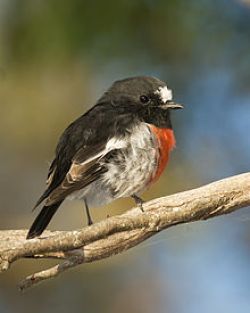
Common Name:- Scarlet Robin
Species:- Petroica boodang
Other Common Names:- Red Robin
The Scarlet Robins are stocky passerines with large heads. They range in size from 12 to 13.5 cm in length and weigh between 12 and 14 g. The plumage is sexually dimorphic. The males have black heads, backs and tails, black and white wings, a red breast and white belly, forehead and rump. The female matches the male in pattern but is duller, with brown plumage instead of black, a much more washed out red on the breast and a buff belly. Juvenile birds resemble the female without the reddish wash on the breast.

Common Name:- Red Capped Robin
Species:- Petroica goodenovii
Other Common Names:- Red Robin
The male Red-capped Robin is black above and white below with a distinctive scarlet-red cap, white shoulders, and a red breast that contrasts strongly with a black throat. The black wing is barred white and the tail is black with white edges. Females are quite different in appearance: grey-brown above and off-white below, with a reddish cap, brown-black wings barred buff to white, and some have faint red on the breast. Young birds are similar to females but are streaked white above, have an pale buff wing bar and their breast and sides are streaked or mottled dark-brown.

Common Name:- Flame Robin
Species:- Petroica phoenicea
Other Common Names:- often simply but inaccurately called the Robin Redbreast
Male Flame Robins have a bright orange breast and throat, and are white on the lower belly and undertail. The top of their head and back is dark slate grey and there is a clear white stripe on the folded wing. The bill is black and the legs dark brown. The female is quite different from the male, being mostly grey-brown with a pale buff wing stripe, and a mostly white outer tail feather. Young Flame Robins resemble the adult female, but the brown of the back is heavily streaked with buff and the pale belly is streaked with brown.

Common Name:- Rose Robin
Species:- Petroica rosea
Other Common Names:- Red Robin
The Rose Robin is a slender robin with a relatively long tail. Males are dark grey above, with a white patch above the bill (frontal patch), and have a rose-pink breast. The lower part of the underbody and outer tail feathers are white, the wings and upper tail dark grey. Females are mainly brown-grey above with a small white frontal patch, white outertail and wing bars, and off-white below, with occasional pale pink wash across breast. Young birds resemble females, but are streaked white above, usually lack the white frontal patch, and are mottled darked brown underneath, with less or no pink. Rose Robins are the most acrobatic of the red robin genus (Petroica) with a darting, tumbling flight, and forage higher up in the canopy.
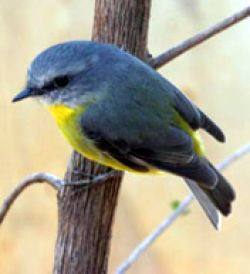
Common Name:- Eastern Yellow Robin
Species:- Eopsaltria australis
Other Common Names:-
The Eastern Yellow Robin is a medium sized robin. It has a grey back and head, and yellow underparts. Southern birds have an olive-yellow rump, while in northern birds it is brighter yellow. The throat is off-white and, in flight, there is a pale off-white wing bar. The bill is black. Both sexes are similar in plumage colour and pattern, but the female is slightly smaller. Young Eastern Yellow Robins are rufous-brown. The plumage has some paler streaks, which are confined to the wings when the birds are a little older.
EASTERN WHIPBIRD

Common Name:- Eastern Whipbird
Species:- Psophodes olivaceus
Other Common Names:-
Adult Eastern Whipbirds are mostly dark olive-green above, with a long tail, and a grey-white belly. The head and breast are black, with a broad white patch on the side of the face and a black crest. The eye is pale cream and the bill is black. Young whip birds are generally duller, with a smaller crest. The white cheek patch is absent in very young birds, and increases in size as the birds mature.
WHISTLERS AND ALLIES

Common Name:- Golden Whistler
Species:- Pachycephala pectoralis
Other Common Names:-
The adult male Golden Whistler is bright yellow on the underside, olive-green on the back and wings, and black on the head with a bright yellow collar. The throat is white, separated from the yellow chest by a broad black band. The bill and legs are black. Females lack bright plumage. They are generally grey above, with a pale olive tinge, and paler grey below, with a buff wash. The bill is dark brown and the legs grey-brown. The eye is red-brown in adults of both sexes. Young Golden Whistlers are rufous. As they mature, the plumage comes to resemble that of the female other than rufous edges to some wing feathers. These are later replaced as the bird matures.

Common Name:- Grey Shrikethrush
Species:- Colluricincla harmonica
Other Common Names:- Grey Shrike-thrush formerly commonly known as Grey Thrush
The Grey Shrike-thrush is a rather drab coloured bird, although the plumage varies throughout its extensive range. Birds are mostly grey in the east, with an olive-grey back, and pale grey-white cheeks and underparts. In the north, the plumage is predominantly brown, and western birds are grey with buff underparts. Adult males are browner on the mantle than the female and young birds have varying amounts of rufous on the cheeks and wings.

Common Name:- Crested Shriketit
Species:- Falcunculus frontatus
Other Common Names:- Eastern Shriketit
The Crested Shrike-tit is a medium-small bird with a striking black and white striped head and neck, a small crest that is often held flattened over crown, a black throat, and a short heavy bill with hooked tips. It has wide, rounded wings and a square-tipped tail that can appear slightly forked. The species is separated into three geographically isolated subspecies. Males of the Eastern Shike-tit, frontatus, have an olive green back and rump, striking yellow underparts, with grey wings and
tail. Females of all races have a smaller head crest and an olive-green throat. Young birds have a pale throat and a brown back.
BLACK-FACED MONARCH
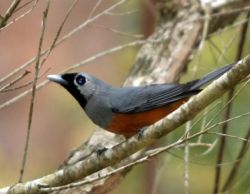
Common Name:- Black-faced Monarch
Species:- Monarcha melanopsis
Other Common Names:-
The Black-faced Monarch has a distinctive black face that does not extend across the eyes, grey upperparts, wings and upper breast, contrasting with a rufous (red-orange) belly. The dark eye has a thin black eye ring and a lighter area of pale grey around it. The blue-grey bill has a hooked tip. Young birds are similar but lack the black face, have a black bill and tend to have a brownish body and wings. The Black-faced Monarch is one of the monarch flycatchers, a forest and woodland-dwelling group of small insect-eating birds, and is strictly arboreal (found in trees).
FANTAILS

Common Name:- Grey Fantail
Species:- Rhipidura albiscapa or Rhipidura fuliginosa
Other Common Names:-
The Grey Fantail is most easily recognised by its constantly fanned tail and agile aerial twists and turns. Both sexes are similar in appearance: grey above, with white eyebrow, throat and tail edges. This species is quite inquisitive and will closely approach an observer.

Common Name:- Rufous Fantail
Species:- Rhipidura rufifrons
Other Common Names:-
The Rufous Fantail is a small, active bird which has a distinctive reddish brown rump and continuously fanned tail. The crown, face, neck and shoulders are grey-brown, shading to reddish brown on the lower back, rump and upper tail. The eyebrow is reddish-brown, the chin and throat are white, grading into a dappled black and white breast, and the rest of the underparts are white tinged red-brown. The wings are grey-brown and the tail feathers have red-brown bases, but are otherwise dark grey, tipped white. Young birds are similar, but duller, with less distinct markings on the breast.
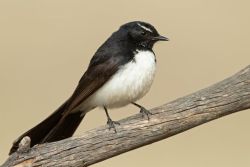
Common Name:- Willie Wagtail
Species:- Rhipidura leocophrys
The willie wagtail is insectivorous and spends much time chasing prey in open habitat. Its common name is derived from its habit of wagging its tail horizontally when foraging on the ground. Aggressive and territorial, the willie wagtail will often harass much larger birds such as the laughing kookaburra and wedge-tailed eagle. It has responded well to human alteration of the landscape and is a common sight in urban lawns, parks, and gardens. It is widely featured in Aboriginal folklore around Australia and New Guinea in a variety of roles, from stealer of secrets and liar to a good omen for successful crops.
CUCKOO-SHRIKES
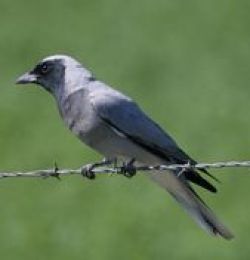
Common Name:- Black Faced Cuckoo Shrike
Species:- Coracina novaehollandiae
Other Common Names:-
Black-faced Cuckoo-shrikes have a black face and throat, blue-grey back, wings and tail, and white underparts. They are slender, attractive birds. They have a curious habit of shuffling their wings upon landing, a practice that gave rise to the name "Shufflewing", which is often used for this species. This shuffling is also carried out by most other species in this family. Young birds resemble the adults, except the black facial mask is reduced to an eye stripe.
CURRAWONGS AND ALLIES
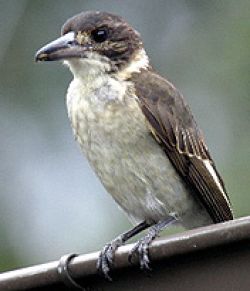
Common Name:- Grey Butcherbird
Species:- Cracticus torquatus
Other Common Names:-
The adult Grey Butcherbird has a black crown and face and a grey back, with a thin white collar. The wings are grey, with large areas of white and the underparts are white. The grey and black bill is large, with a small hook at the tip of the upper bill. The eye is dark brown and the legs and feet are dark grey. Both sexes are similar in plumage, but the females are slightly smaller than the males. Young Grey Butcherbirds resemble adults, but have black areas replaced with olive-brown and a buff wash on the white areas. The bill is completely dark grey and often lacks an obvious hook. They are sometimes mistaken for small kingfishers.
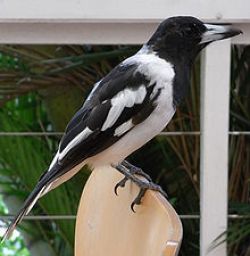
Common Name:- Pied Butcherbird
Species:- Cracticus nigrogularis
Other Common Names:-
The Pied Butcherbird is a medium-sized black and white bird. It has a full black hood, dark brown eye and long, hooked, grey and black bill. It has a broad white collar that goes all around its neck and a black bib (throat area). The rest of the underparts are white and the legs are black. The upper parts are mostly black, with large patches of white on the wings and rump. In flight, the white corners of the otherwise black tail are easily seen. Both sexes have identical plumage, but the male is slightly larger than the female. Young Pied Butcherbirds are generally duller than the adults are. The areas of black are replaced with brown and white areas are washed with buff. The birds also have an ill-defined bib, which becomes more distinct with age.

Common Name:- Pied Currawong
Species:- Strepera graulina
Other Common Names:- Pied Chillawong, Currawang, Charawack, Kurrawack, Tallawong, Tullawong, Mutton-bird, Otway Forester, and Pied Afternoon-tea Bird
The Pied Currawong is a large, mostly black bird, with a bright yellow eye. Small patches of white are confined to the under tail, the tips and bases of the tail feathers and a small patch towards the tip of each wing (visible in flight). The bill is large and black and the legs are dark grey-black. Both sexes are similar, although the female may sometimes be greyer on the underparts. Young Pied Currawongs are duller and browner than the adults.
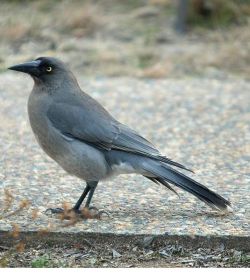
Common Name:- Grey Currawong
Species:- Strepera versicolor
Other Common Names:- Grey Crow-shrike, Leaden Crow-shrike, Mountain Magpie
Similar to other currawongs in that it is a mainly dark bird with some white markings and a yellow eye, the Grey Currawong is however a highly variable species, with six distinct subspecies throughout its range. All subspecies have a white-tipped tail. These include: the nominate 'originally named') race, versicolor, which is variably grey to grey-brown, with a white tail-tip, undertail and white across wings.
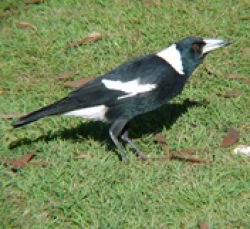
Common Name:- Australian Magpie
Species:- Cracticus tibicen or Gymnorhina tibicen
Other Common Names:-
The Australian Magpie is black and white, but the plumage pattern varies across its range. Its nape, upper tail and shoulder are white in males, grey in females. Across most of Australia, the remainder of the body is black. In the south-east, centre, extreme south-west and Tasmania, the back and rump are entirely white. The eye of adult birds is chestnut brown.
RAVENS AND CROWS

Common Name:- Australian Raven
Species:- Corvus coronoides
Other Common Names:- Alternate names include Southern Raven, Southern Crow, and Kelly
Australian Ravens are black with white eyes in adults. The feathers on the throat (hackles) are longer than in other species, and a bird tends to extend these when calling, while holding its head and body in a horizontal position. Australian Ravens are usually seen in pairs. Another aid to identification of this species is the absence of wing-flicking while calling. Young birds resemble the adults, but have dark eyes, shorter throat hackles and often the presence of a pink, fleshy gape. This species is sometimes called a crow.
WHITE-WINGED CHOUGH

Common Name:- White-winged Chough
Species:- Corcorax melanorhamphos
Other Common Names:-
The White-winged Chough is a large, almost completely black bird. It has a curved beak, a red eye and a large white wing patch, which is seen when the bird is in flight. The bill and legs are black. Both male and female share the same plumage pattern. Young White-winged Choughs start off duskier than the adults, and the eye is brown. They do not reach sexual maturity until four years of age and, during this time, the eye changes from brown to orange and then to red, and the plumage darkens.
SATIN BOWERBIRD

Common Name:- Satin Bowerbird
Species:- Ptilonorhynchus violaceus
Other Common Names:-
Satin Bowerbirds are medium-sized birds. The adult male has striking glossy blue-black plumage, a pale bluish white bill and a violet-blue iris. Younger males and females are similar in colour to each other, and are collectively referred to as 'green' birds. They are olive-green above, off-white with dark scalloping below and have brown wings and tail. The bill is browner in colour. Young males may begin to acquire their adult plumage in their fifth year and are not fully 'attired' until they are seven.
FINCHES
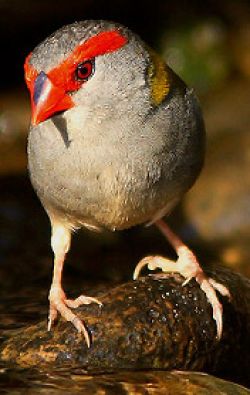
Common Name:- Red-Browed Finch
Species:- Neochmia temporalis
Other Common Names:-
The Red-browed Finch is most easily recognised by its bright red eyebrow, rump and beak, on an otherwise green and grey bird. Upperparts are olive green with grey underneath. Both sexes are similar in appearance. Often observed in small flocks, which feed on the grass. They will fly into dense undergrowth when disturbed by a passer-by. Red-browed Finches may also be called Red-browed Firetails.
MISTLETOEBIRD

Common Name:- Mistletoebird
Species:- Dicaeum hirundinaceum
Other Common Names:-
The small Mistletoebird is the only Australian representative of the flowerpecker family, Dicaeidae, and is also known as the Australian Flowerpecker. Males have a glossy blue-black head, wings and upperparts, a bright red throat and chest, a white belly with a central dark streak and a bright red undertail. Females are grey above, white below, with a grey streak on the belly, and a paler red undertail. Young birds resemble females but are paler and have an orange, rather than dark, bill. These birds are swift and erratic fliers, moving singly or in pairs, usually high in or above the canopy.
SWALLOWS AND MARTINS
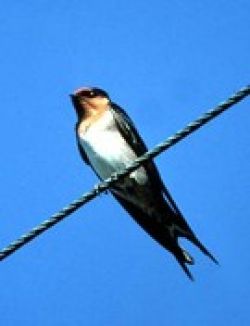
Common Name:- Welcome Swallow
Species:- Hirundo neoxena
Other Common Names:-
The Welcome Swallow is metallic blue-black above, light grey below on the breast and belly, and rust on the forehead, throat and upper breast. It has a long forked tail, with a row of white spots on the individual feathers. The outer tail feathers (streamers) are slightly shorter in the female. Young Welcome Swallows are buffy white, instead of rusty, on the forehead and throat, and have shorter tail streamers.

Common Name:- Fairy Martin
Species:- Petrochelidon ariel or Hirundo ariel
Other Common Names:-
The Fairy Martin is a small bird, with dark wings, a white underbody and a pinkish-red head. The short, slightly forked tail appears square in flight. It is gregarious, feeding in large flocks and nesting in colonies.
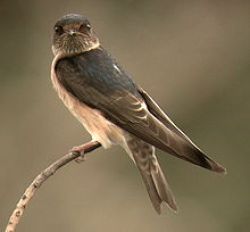
Common Name:- Tree Martin
Species:- Petrochelidon nigricans
Other Common Names:-
The Tree Martin averages 13 cm long and has a shallowly forked tail. The adult has an iridescent blue back and crown, brown wings and tail, a rufous forehead and a whitish rump. The underparts are white. The sexes are similar, but young birds are duller and browner, with a paler forehead and pale fringes to the back and wing feathers.
SONGLARKS
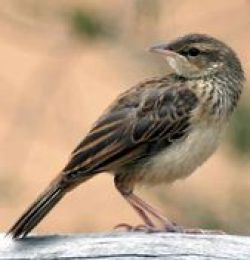
Common Name:- Rufous Songlark
Species:- Cincloramphus mathewsi
Other Common Names:-
The Rufous Songlark is a mid-brown, streaked bird with a rufous rump and upper tail, pale eyebrow and pale underparts, and a dark line through its eye. In the breeding season the melodious song of the male Rufous Songlark is heard almost continuously, both from perches and in slow display flights between trees. The male (about 19 cm) is larger than the female (about 16 cm).

Common Name:- Brown Songlark
Species:- Cincloramphus cruralis
Other Common Names:-
The Brown Songlark is remarkable for the male being much larger (23-25 cm) than the female (18-19 cm). In breeding plumage the male is dark cinnamon-brown with black bill and black eyes. Otherwise the male and female both have a dusky brown back, pale brownish-white underparts, with the centre of the belly dark brown. The Brown Songlark is also known as the Australian Songlark.
SILVEREYE

Common Name:- Silvereye
Species:- Zosterops lateralis
Other Common Names:- Wax-eye, White-eye
The Silvereye is a small bird with a conspicuous ring of white feathers around the eye, and belongs to a group of birds known as white-eyes. The Silvereye shows interesting plumage variations across its range. The grey back and olive-green head and wings are found in birds through the east, while western birds have a uniformly olive-green back. Breeding birds of the east coast have yellow throats, pale buff flanks (side of the belly) and white on the undertail. Tasmanian birds have grey throats, chestnut flanks and yellow on the undertail. To complicate this, the birds in the east have regular migrations within Australia and may replace each other in their different areas for parts of the year.
BASSIAN THRUSH

Common Name:- Bassian Thrush
Species:- Zoothera lunulata
Other Common Names:- Olive-tailed Thrush, Australian Ground Thrush, White's Thrush, Scaly Thrush
The Bassian Thrush is a secretive bird. Its plumage is mottled brown to olive-brown, heavily scalloped with black crescent-shaped bars on the back, rump and head. The paler underparts all have brown-black scalloping. It has a white eye-ring. In flight the Bassian Thrush shows a broad dark diagonal bar across the white underside of its wing. This species has also been referred to as White's Thrush, Ground Thrush, and Scaly Thrush.
INTRODUCED BIRDS

Common Name:- Red-whiskered Bulbul
Species:- Pycnonotus jocosus
Other Common Names:-
The Red-whiskered Bulbul is not easily mistaken for any other species of bird in Australia. It has a pointed black crest, white cheeks, brown back, reddish under tail coverts and a long white-tipped tail. The red whisker mark, from which it gets its name, is located below the eye, but is not always easy to see. Both male and female birds are similar in plumage, while young birds are duller with a greyish-black crown. Red-whiskered Bulbuls are not timid around humans, perching prominently on the top of bushes or on power lines.

Common Name:- Common Blackbird
Species:- Turdus merula
Other Common Names:- Eurasian Blackbird
Libby Raines has passed on the story that the Blackbird is said to have come to this area in 1957 following the big bushfires. Apparently some Blackbirds kept in captivity in Leura were released when the fires swept through. Uncommonly for a fire season, the winds were from the south southwest and some of the released Blackbirds flew to the Mt Wilson area and settled here. It was after the fires the first Blackbird calls were heard, and they now seem to have settled and multiplied.
The Common Blackbird was introduced to Australia at Melbourne in the 1850s. The male is the 'black' bird, with deep orange to yellow bill, a narrow yellow eye-ring and dark legs. The female is a brown bird, with some streaks or mottling, and has a dark bill and legs. Immature birds are similar to the female with lighter underparts.

Common Name:- Common Starling
Species:- Sturnus vulgaris
Other Common Names:- European Starling or just Starling
The Common Starling has a wide variation in plumage. Both sexes are similar, although the female is less glossy than the male. In autumn, when the plumage is new, birds are glossed black, with a purple and green shine, and the tips of the body feathers have large white spots. At this time the bill is dark and the legs are brown. With wear, the white spots are lost, while the bill and legs turn yellow. During the breeding season adults become glossy-black without any spots. Young birds are dull grey-brown.
